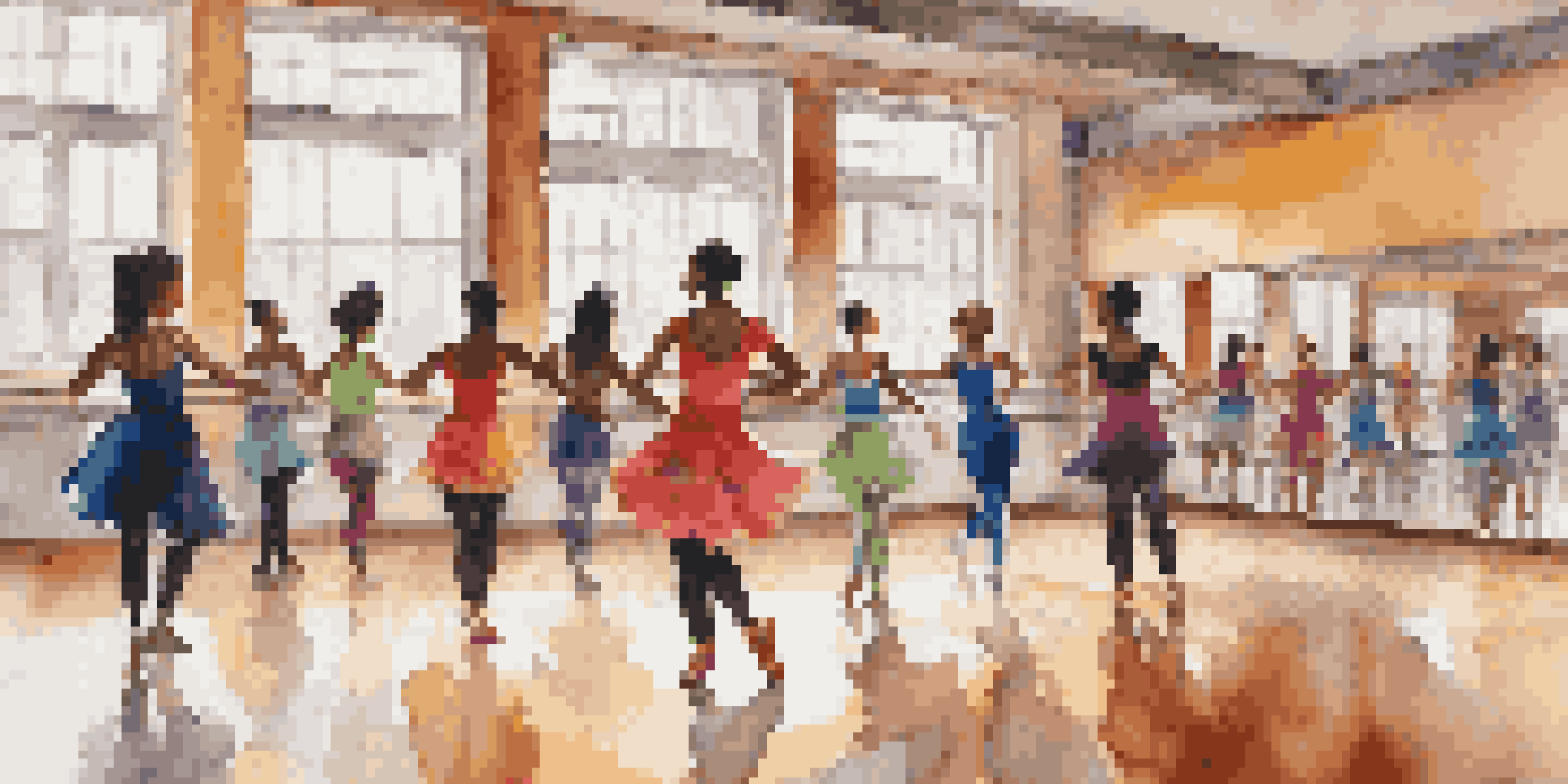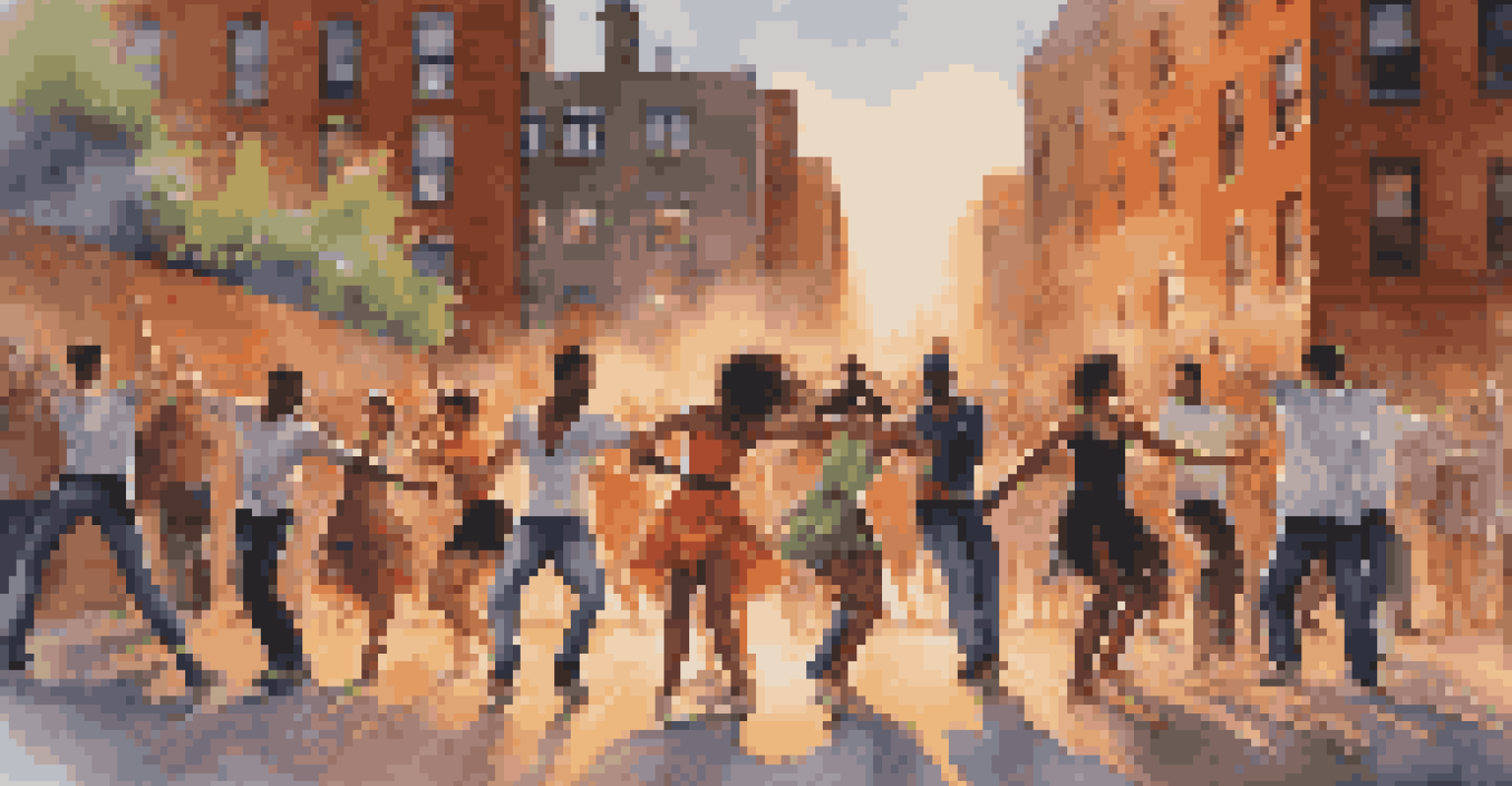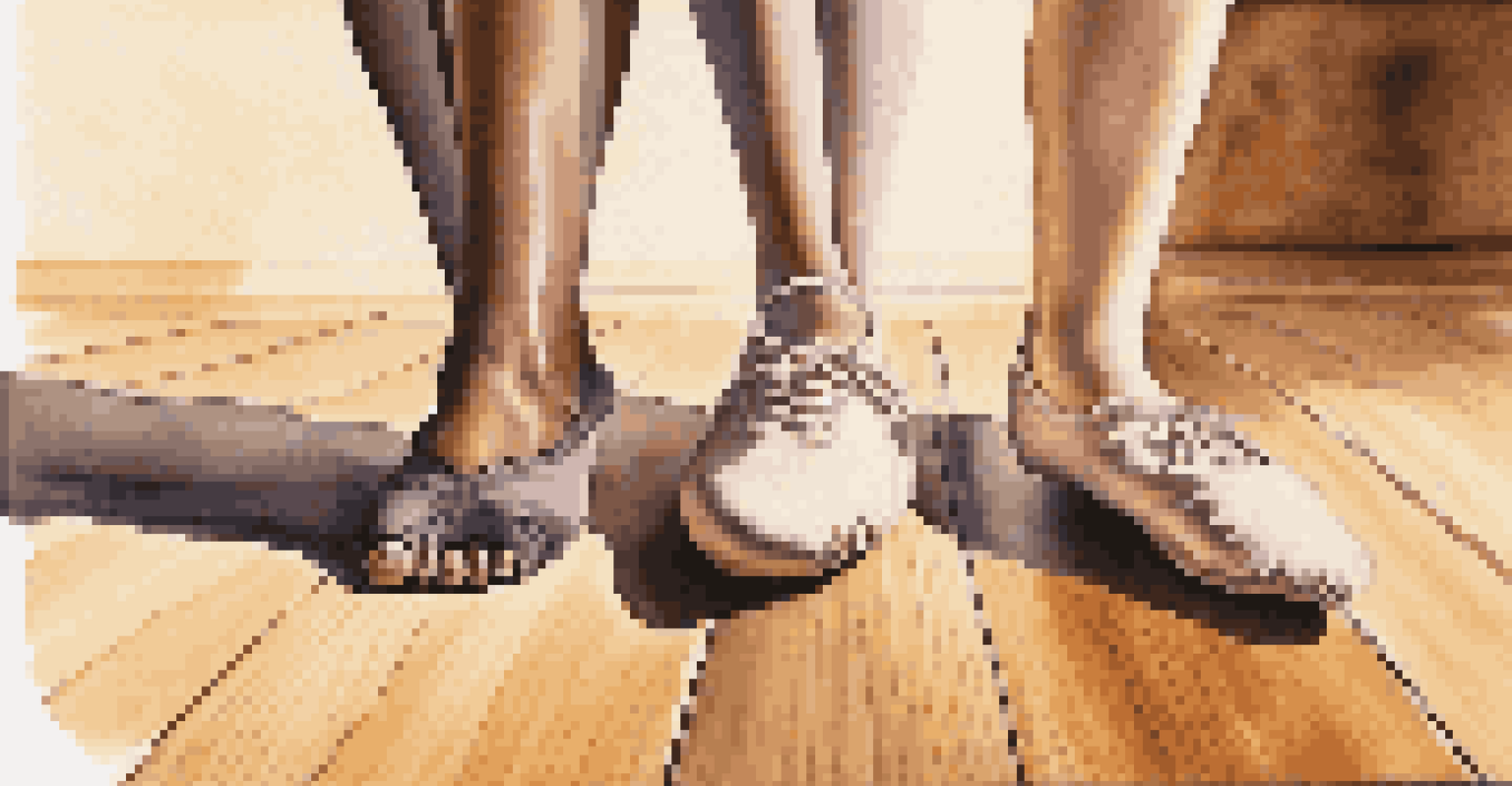Dance and Gender Roles in Pop Culture: A Critical Review

The Evolution of Dance and Gender Roles in Society
Dance has always been a mirror reflecting societal norms, including gender roles. Historically, men and women have been assigned specific dance styles that reinforce traditional roles, such as ballet for women and breakdancing for men. However, these categories are starting to blur, with more artists challenging these norms, illustrating a shift towards equality in expression. This evolution prompts us to reconsider what we understand about gender and dance.
Dance is the hidden language of the soul.
For instance, the rise of contemporary dance has allowed for more fluidity in expression, enabling both genders to participate in a variety of styles. This change reflects broader societal shifts, where the lines between masculinity and femininity are increasingly blurred. As we see more mixed-gender performances, it becomes evident that dance is not just an art form but a powerful medium for questioning and redefining gender roles.
Moreover, platforms like social media have amplified this conversation, giving rise to viral dance challenges that often showcase a diverse range of participants. These trends indicate that audiences are becoming more accepting of non-traditional gender expressions in dance, highlighting a cultural shift that resonates beyond the dance floor.
Dance in Music Videos: A Gendered Lens
Music videos have long served as a canvas for dance, often reinforcing gender stereotypes. Typically, female dancers have been portrayed in a way that emphasizes their physicality, while male dancers often exhibit strength and power. This visual dichotomy not only reflects but also perpetuates traditional gender norms, influencing how audiences perceive masculinity and femininity. For instance, videos featuring female pop stars frequently showcase them in provocative ways, while male performers may focus more on athleticism.

However, there are notable exceptions that challenge these conventions. Artists like Beyoncé and Lizzo use their platforms to celebrate body positivity and female empowerment through dance. Their choreography often subverts traditional expectations, allowing women to express strength and autonomy. These performances serve as a reminder that dance can be a vehicle for both personal expression and social commentary.
Dance Reflects Evolving Gender Roles
Dance serves as a powerful medium that mirrors and challenges traditional gender norms, showcasing a shift towards more fluid expressions of identity.
As viewers, we must critically engage with these portrayals in music videos. By recognizing the underlying messages about gender roles, we can appreciate how dance not only entertains but also shapes our understanding of identity and power in contemporary culture.
The Role of Dance Competitions in Gender Perceptions
Dance competitions, from television shows to local contests, have become a prominent platform for showcasing talent and creativity. However, they also highlight the complexities of gender roles within the dance community. Often, female dancers are praised for their grace and beauty, while male dancers are judged based on their strength and technical skills. This disparity can influence young dancers' aspirations and self-image, pushing them towards specific styles that align with societal expectations.
The body says what words cannot.
For example, shows like 'So You Think You Can Dance' often feature choreography that emphasizes traditional gender roles. Female contestants may perform more lyrical or contemporary pieces, while males are often seen in hip-hop or breaking. This pattern not only shapes the participants' experiences but also affects the audience's perception of what dance should embody according to gender.
Yet, many dancers and choreographers are challenging these norms by incorporating diverse styles and celebrating individuality. By breaking free from the constraints of gendered expectations, these performers inspire a new generation to embrace all forms of dance, regardless of gender, fostering an environment that values creativity over conformity.
Cultural Influences on Dance and Gender Roles
Dance is deeply rooted in cultural traditions, which often dictate gender roles. Different cultures have unique dance styles that reflect their historical and social contexts, influencing how gender is performed and perceived. For instance, traditional Indian dance forms often depict gender roles within storytelling, showcasing women in nurturing or romantic roles while men take on heroic characters. Such representations can reinforce traditional views on gender, limiting the potential for more equitable portrayals.
However, globalization and cultural exchange are changing the landscape of dance. As we witness the fusion of styles from different cultures, there is an opportunity to challenge and redefine gender roles. Contemporary dance, for example, often borrows elements from various traditions, allowing for a more inclusive representation of gender. This blending not only enriches the art form but also encourages audiences to embrace diversity in gender expression.
Media Shapes Gender Perceptions
Music videos and social media play pivotal roles in reinforcing or subverting gender stereotypes, influencing how audiences perceive masculinity and femininity.
Ultimately, understanding the cultural influences on dance can help us appreciate the nuances of gender representation. As dancers draw from a wealth of traditions, they can create pieces that challenge stereotypes and celebrate the complexity of identity, paving the way for a more inclusive future.
The Impact of Social Media on Dance and Gender Identity
Social media has revolutionized the way we consume and engage with dance, providing a platform for diverse expressions of gender identity. Platforms like TikTok and Instagram allow dancers to share their work with global audiences, breaking down traditional barriers. This accessibility has empowered individuals to showcase their unique styles, often defying conventional gender norms in the process. As a result, we see a rich tapestry of dance that reflects a multitude of identities.
Moreover, social media challenges the notion of a singular narrative around gender and dance. Dancers can experiment with their presentation, using choreography to express their gender identity and challenge societal expectations. For example, many creators blend movements from various dance styles, defying the idea that certain styles are 'for' one gender or another. This fluidity encourages viewers to embrace their own identities, promoting a more inclusive understanding of gender.
However, this shift is not without challenges. The pressure to conform to trending styles can lead to a homogenization of dance, where individual expression may be stifled. Yet, the overall impact of social media on dance remains significant, as it continues to challenge traditional gender roles and inspire a generation to express themselves authentically.
Dance and Gender Roles in Film and Theatre
Film and theatre have long been influential in shaping perceptions of gender through dance. From classic musicals to contemporary films, the portrayal of dancers often reflects societal attitudes towards masculinity and femininity. For instance, iconic films like 'West Side Story' and 'Dirty Dancing' depict traditional gender roles, with men often exhibiting aggression and women portraying vulnerability. These portrayals can reinforce stereotypes, affecting how audiences perceive gender in real life.
However, as the industry evolves, we are beginning to see more progressive representations. Films like 'Footloose' and 'La La Land' challenge traditional roles by showcasing strong, independent female characters who are equally adept in dance. This shift not only enriches the narrative but also allows for a broader understanding of gender roles, encouraging audiences to see beyond stereotypes.
Cultural Exchange Redefines Dance
Globalization and cultural fusion in dance offer opportunities to challenge conventional gender portrayals, promoting inclusivity and diversity in expression.
Furthermore, the rise of dance theatre has introduced new forms of storytelling that prioritize authentic expressions of gender. Choreographers are now experimenting with movement to explore themes of identity, power, and sexuality, creating works that resonate deeply with contemporary audiences. In doing so, they are redefining what it means to dance and be gendered in today’s world.
Conclusion: The Future of Dance and Gender Roles
As we reflect on the interplay between dance and gender roles, it’s clear that this relationship is in constant flux. From traditional representations to contemporary explorations, dance continues to be a powerful medium for questioning and redefining gender norms. The ongoing evolution of gender roles in society is mirrored in the dance community, where artists are bravely pushing boundaries and challenging stereotypes. This dynamic landscape offers a glimpse into a future where dance may truly become a space for all identities to flourish.
Moreover, the influence of social media, cultural exchange, and shifting societal attitudes will continue to shape the way we understand dance and gender. As audiences become more engaged with diverse expressions of identity, we may see a significant transformation in how dance is presented and perceived. This change will ultimately foster an environment where everyone feels empowered to express themselves through movement, regardless of gender.

In conclusion, dance is not just an art form; it is a reflection of our collective journey towards understanding and embracing gender diversity. By engaging critically with the dance we consume and create, we can contribute to a more inclusive narrative that celebrates the richness of human expression.